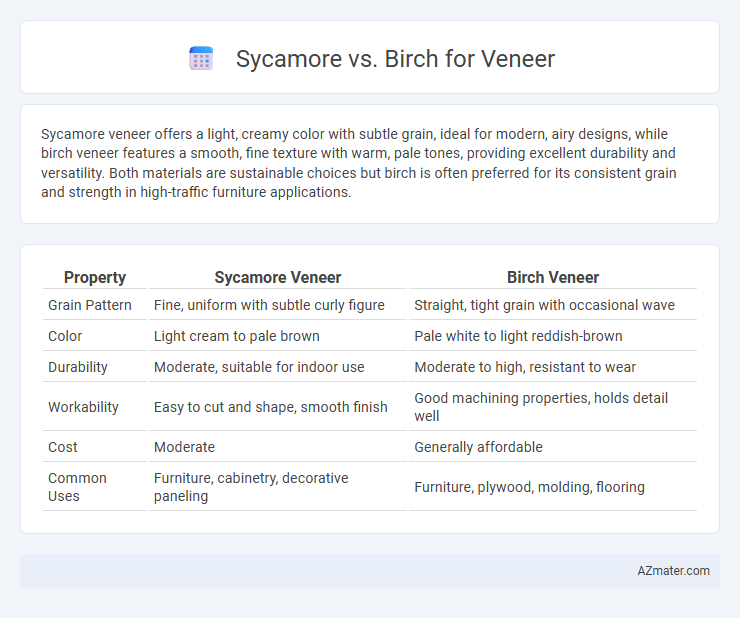Sycamore veneer offers a light, creamy color with subtle grain, ideal for modern, airy designs, while birch veneer features a smooth, fine texture with warm, pale tones, providing excellent durability and versatility. Both materials are sustainable choices but birch is often preferred for its consistent grain and strength in high-traffic furniture applications.
Table of Comparison
| Property | Sycamore Veneer | Birch Veneer |
|---|---|---|
| Grain Pattern | Fine, uniform with subtle curly figure | Straight, tight grain with occasional wave |
| Color | Light cream to pale brown | Pale white to light reddish-brown |
| Durability | Moderate, suitable for indoor use | Moderate to high, resistant to wear |
| Workability | Easy to cut and shape, smooth finish | Good machining properties, holds detail well |
| Cost | Moderate | Generally affordable |
| Common Uses | Furniture, cabinetry, decorative paneling | Furniture, plywood, molding, flooring |
Introduction to Sycamore and Birch Veneers
Sycamore veneer features a fine, uniform texture with a subtle, light cream to pale brown color, prized for its smooth finish and excellent workability in furniture and cabinetry. Birch veneer offers a close-grained, pale yellow to light brown surface, known for its strength and versatility in both modern and traditional woodworking projects. Both veneers are valued for their durability and aesthetic appeal, making them popular choices in interior design applications.
Botanical Overview: Sycamore vs Birch
Sycamore (Platanus spp.) features broad, lobed leaves and exfoliating bark, thriving in temperate regions with rapid growth ideal for veneer production. Birch (Betula spp.) showcases smooth, papery bark and ovate leaves, commonly found in cooler climates, offering a fine-grain texture preferred in high-quality veneer applications. Both species provide durable hardwood veneers, with sycamore prized for its unique grain patterns and birch valued for consistent color and smooth finish.
Visual Characteristics and Grain Patterns
Sycamore veneer displays a creamy white to light reddish-brown color with a fine, uniform texture and subtle curly or wavy grain patterns that create a visually soft and elegant appearance. Birch veneer features a pale cream to light yellowish tone with a smooth, even texture and straight grain patterns that offer a clean, consistent look ideal for modern or minimalist designs. Sycamore's distinctive figuring and warm hues contrast with birch's more subdued coloration and linear grain, making choice dependent on the desired aesthetic impact.
Color and Aesthetic Appeal
Sycamore veneer features a creamy white to light tan color with subtle, wavy grain patterns that create a smooth, elegant aesthetic ideal for modern interiors. Birch veneer offers a pale yellow to light brown hue with a fine, even texture and uniform grain, providing a warm and consistent look favored in traditional and Scandinavian designs. Both woods deliver a clean, bright appearance, but Sycamore's distinctive grain provides a slightly more dynamic visual interest compared to Birch's subtle uniformity.
Workability and Machining Properties
Sycamore veneer offers excellent workability with a fine, even texture that machines smoothly, producing clean cuts and minimal tear-out. Birch veneer is known for its consistent density and strength, allowing for precise machining and good glue adhesion, though it can blunt tools faster than Sycamore. Both woods respond well to sanding and finishing, but Sycamore's softer grain provides easier handling during complex veneer applications.
Durability and Longevity of Veneer
Sycamore veneer offers moderate durability, with a fine, consistent grain that resists warping and maintains stability over time in indoor applications. Birch veneer is known for its exceptional hardness and resilience, providing superior longevity and resistance to dents and scratches under regular use. Both veneers perform well, but birch is generally preferred for projects requiring enhanced durability and long-lasting finishes.
Cost Comparison: Sycamore vs Birch Veneer
Sycamore veneer typically costs more than birch veneer due to its unique grain patterns and limited availability, making it a premium choice for high-end furniture and cabinetry. Birch veneer is generally more affordable, offering a smooth and uniform appearance that suits budget-conscious projects without compromising quality. Buyers often select birch veneer for cost-effective applications while choosing sycamore veneer when aesthetics and exclusivity justify the higher price.
Common Applications in Furniture and Interiors
Sycamore veneer is prized for its light, creamy color and fine, even grain, making it ideal for modern furniture and interior paneling that emphasize brightness and subtle texture. Birch veneer offers a slightly stronger grain with a warm, pale-yellow hue, commonly used in cabinetry, plywood, and Scandinavian-style furniture due to its durability and smooth finish. Both veneers suit cabinetry, wall panels, and decorative furniture but differ in aesthetic impact, with sycamore favored for contemporary spaces and birch preferred for versatile, classic interiors.
Environmental Impact and Sustainability
Sycamore veneer is often regarded as more sustainable due to the tree's rapid growth rate and ability to thrive in diverse environments, contributing to faster replenishment and lower ecological footprint. Birch veneer, while prized for its durability and fine grain, typically comes from slower-growing trees, raising concerns about deforestation and habitat disruption if not sourced responsibly. Choosing certified sustainable sources for both wood types ensures reduced environmental impact and supports forest conservation efforts.
Choosing the Right Veneer: Sycamore or Birch?
Sycamore veneer offers a distinctive grain pattern with subtle, wavy figures, making it ideal for decorative applications requiring a unique appearance. Birch veneer, known for its consistent light color and fine, uniform grain, provides a clean and modern aesthetic suitable for contemporary furniture and cabinetry. Selecting between Sycamore and Birch veneers depends on the desired visual effect and project requirements, balancing Sycamore's character against Birch's smooth, even texture.

Infographic: Sycamore vs Birch for Veneer
 azmater.com
azmater.com